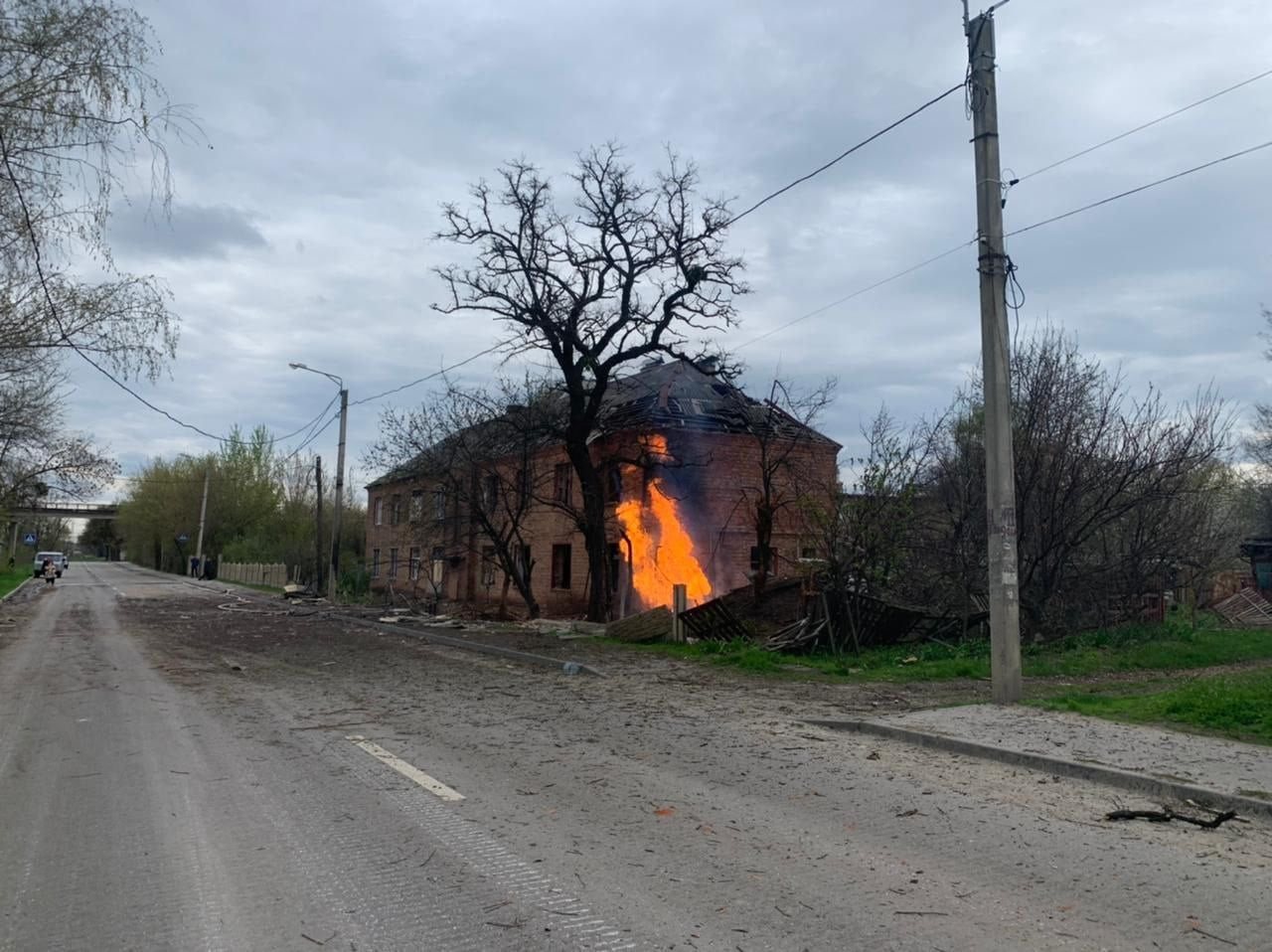By Serhiy Petrov
There were fewer attacks than yesterday, primarily because our military kept the muscovites busy with other matters. At the same time, the northern suburbs have been suffering a lot of shelling, and today the ruscists also hit the southern suburbs of Kharkiv. Unfortunately, there are many destroyed and damaged houses, dead, and wounded. Also, the village of Kutuzivka, east of Kharkiv, was liberated. Fighting continues for Ruska Lozova, north of the city. Very heavy battles are ongoing in the southeast of the region.

While there weren’t as many attacks as yesterday, the muscovites continued attacking the city. Different areas of Saltivka suffered the most. Both Selyshche Zhukovskoho and Pyatykhatky were shelled, as well as the outskirts of Oleksiyivka. However, there was very little shelling in Obriy and the outskirts of the Kharkiv Tractor Plant neighborhood. Unfortunately, people neglect to take security measures in their neighborhoods, because there is less shelling now compared to mid-April. So, there have been cases when people got injured and killed by shelling while out in yards and not inside buildings. Two people were killed and four others were injured in the city today.
The muscovites continue intensive shelling of the northern suburbs, including Derhachi, Slatyne, Prudyanka, and other settlements of the Derhachiv Hromada, as well as the town of Mala Danylivka. One person was killed in the Derhachi Hromada. Some houses there were destroyed and damaged.
The ruscist shelling of the village of Zolochyv is also continuing. Some houses have been destroyed and damaged, but, fortunately, none of the residents were injured.
Today, the muscovites shelled the southern suburbs of Kharkiv. The Pokotylivka settlement was heavily shelled, where residential buildings were destroyed and damaged (about 30 total), as well as a local school. Two people were killed and seven others were injured. In the village of Kotlyary, of Bezlyudivka Hromada, the houses were damaged, one person was killed, and another was injured. The village of Khroly, of the Rohanska Hromada, was also affected. One person was injured there.
Some people are leaving the city after their houses or neighboring buildings were shelled.
From speaking with various people, it’s possible to confirm one way or another that more than half of the population has left the city. However, the other half is still here, because it is their city and their home. Some are also afraid that their homes may get robbed by looters, who despite the danger have been breaking into apartments in Pivnichna Saltivka and stealing all the valuables.
Today was interesting. We traveled with a British journalist, Anthony Borden, who asked locals in Saltivka about the tendency among Kharkivites to speak russian. Не was told that the city maintained a friendly attitude towards muscovites until February 24, after which everything changed radically.
Once the shelling of the city started, any loyalty toward the muscovites that existed was gone, and they are now hated in Kharkiv. The destruction in Saltivka was quite shocking to the guest—who had visited Bucha. Fortunately, there were no atrocities like there were in Bucha, but the scale of the destruction is large. Despite mayor Terekhov’s attempts to continue the Kernes policy that called for “flowers and fountains,” the residents of the wartime city are not very enthusiastic about it, especially in the suburbs, where instead of flowers they hear and see shelling and its consequences. They say it’s funny to see the mayor posing in a bulletproof vest with city workers without bulletproof vests in the background, doing an incredible job while being shelled to keep the city clean and ensure the functioning of all its systems. It seems that the war will change a lot, including an understanding that Kernes’s policy of improvement was really just a way to distract Kharkiv residents.
But it’s all a matter of perspective.
Meanwhile, public utility workers continue to repair supply systems, including supply of both cold and hot water. In some relatively safe areas they are changing the major water mains. Gas companies are repairing gas pipelines and gas distribution stations.
Much of the rubble left in place of destroyed houses has been dismantled, and garbage has been removed—even in the center, where there are many damaged buildings.
Of course, this does not apply to the Pivnichna Saltivka, a portion of the numbered area of the Saltivka district, and partially Selyshche Zhukovskoho and Obriy, where it’s really dangerous.
In the last 63 days, rescuers responded to more than 1,600 fires caused by muscovite shelling of the city. This is a colossal number, and their work continues non-stop, 24/7. About 250 people were rescued; 142 dead bodies were pulled out from the rubble of damaged and destroyed houses. According to the police, 606 people, including 26 children, have been killed in the Kharkiv region during this time. This number is based on information from Ukraine-controlled territories; it’s unknown what is happening in the occupied territories. In the last two weeks alone, 103 people have died from shelling.
There is finally some good news. First, our military has liberated the village Kutuzivka, in the Vilkhyv Hromada, which is 5 km from the district. It is on the road to Staryi Saltiv. Now, the road to the village of Shestakove, where the muscovites have dug in and from where they strike the city, is open, although liberation of those areas will not happen quickly. Finally, the future liberation of Ruska Lozova—there are a few more positive nuances there—just look at the map and you will understand. I hope the amount of shelling in Skhidna Saltivka and the southeastern outskirts of the city will decrease a little.
According to the mayor of Derhachi, Ukrainian troops have entered Ruska Lozova, where fighting continued. They say that the muscovites have already been expelled from there, but the final liberation and clearing the village of enemy fighters—Pyatykhatky and Selyshche Zhukovskoho have been shelled from there—has to wait a little longer.
The situation in the Slovyansk and Barvinkove directions is difficult. Muscovites dominate in numbers and military equipment. Heavy fighting continues, our forces are putting up a defense, but we have to maneuver tactically all the time. Barvinkove is constantly being shelled.
In the occupied territories of the Kharkiv region, muscovites are trying to force entrepreneurs to work by their rules and farmers to start sowing under the threat of “nationalization” of their land. The farmers refuse because of a lack of fuel and lubricants, damaged equipment, and some of the fields being simply dangerous. There have been cases of detonation of ammunition and mines in the fields. In the village of Shevchenkove, the center of the Shevchenkivska Hromada, the ruscists hung a tricolor cloth at the local market, but the residents removed it and then the occupiers threatened to close the market.
Muscovites have lists of Anti-Terrorist Operation participants, and they pay visits to their addresses. There are lists of the most enthusiastic activists. The State Department issued a warning just before the start of the large-scale invasion that the ruscists have such information. Moreover, the team of the Maidan Monitoring Information Center is convinced that on February 27, when several sabotage and reconnaissance groups came to Kharkiv, they were looking for us at the address of the old office, as well as at the new one. It’s hard to say what happened there, but shell casings were found in both offices.
Heavy fighting continues in the Joint Forces Operation zone. The muscovites are trying to attack Lyman, but their attacks in other directions, such as Rubizhne, Severodonetsk, Popasna, Avdiivka, Marinka, Velyka Novosilka, and Huliaipole, have been generally unsuccessful, and the Ukrainian military is successfully resisting, although it is very difficult for them.
A railway bridge collapsed in occupied Yakymivka, near Melitopol. Rumor has it that the muscovites were scared for a good reason. The delivery of equipment, fuel and ammunition to the occupying forces will be delayed for several days until it is repaired.
And grain continues to be taken away from the Kherson region: columns of trucks with grain extend to the Crimea. Muscovites only know how to steal, and they need Ukraine only as a raw materials base. The fate of the local population is the population’s own personal problem.
A lend-lease bill in the US has been passed and is now awaiting Biden’s signature. This is the final formalization of the arms supply process meant to help Ukraine win the war and inflict significant pain on the muscovites. This is a historic event, because such a mechanism was last used during World War II.
The “Kalibr” missile strike on Kyiv during the UN Secretary General’s visit is a clear response by the muscovites to the proposals of the Secretary General himself about Mariupol and an indication of the level of the ruscist consideration of this body. The UN has finally become the League of Nations and now needs either reformatting or liquidation, followed by creation of something new…
In fact, this missile strike means that moscovia has once again pointed out that the invasion of Ukraine is not just a war for the occupation of Ukraine, but a war with the collective West and the civilized world—as they have been saying since the beginning of the war in Syria. Then, the world turned a blind eye to it, but now the situation, as I see it, is changing for good.
Moscovia is restless over the Belhorod “bang” and the fires in a medical center in Moscow and a shopping center in the Tyumen region. Somehow, there has been an increase in the number of fires recently. Karma is a special thing.
Let us believe in our troops and the Armed Forces of Ukraine. Let us help volunteers, medics, rescuers, and public utility workers. Everything will be, Ukraine!






